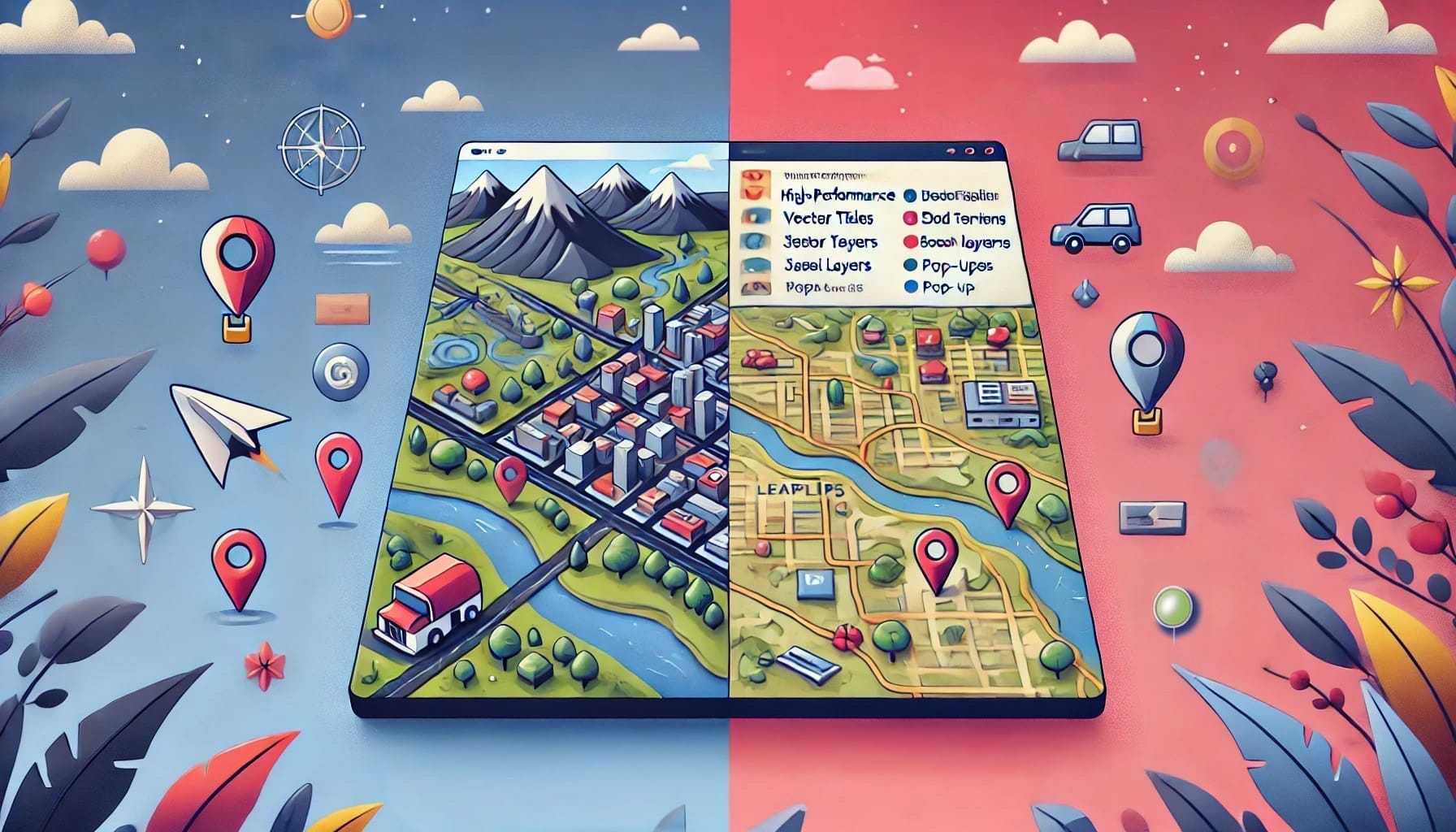MapLibre GL JS vs. Leaflet: Choosing the right tool for your interactive map
Two popular open-source libraries for creating web maps are MapLibre GL JS and Leaflet. Both have unique strengths and cater to different needs. In this post, we'll explore the key differences between the two, helping you make an informed decision for your next mapping project.

Interactive maps have become an essential part of modern web applications, enabling dynamic data visualization and enhanced user experiences. Whether you're creating maps for real estate listings, plotting user data or visualizing delivery routes, choosing the right mapping library is crucial.
Two popular open-source libraries for creating web maps are MapLibre GL JS and Leaflet. Both have unique strengths and cater to different needs. In this post, we'll explore the key differences between the two, helping you make an informed decision for your next mapping project.
Overview of the libraries
MapLibre GL JS
MapLibre GL JS is a community-driven fork of Mapbox GL JS, designed for creating interactive, high-performance vector maps using WebGL. It leverages vector tiles, which are smaller and more efficient than raster tiles, allowing for dynamic styling, smooth animations, and even 3D visualizations. If your project requires advanced features and complex interactivity, MapLibre GL might be the right choice.
Leaflet
Leaflet is a lightweight, user-friendly JavaScript library for creating interactive maps. It has been around for over a decade and has become a go-to tool for developers who need simple yet effective mapping solutions. Leaflet is built on standard web technologies (HTML, CSS, and JavaScript) and is known for its simplicity, extensive plugin ecosystem, and broad compatibility with various browsers.
Key differences between MapLibre GL and Leaflet
Let's dive into the main differences that can help you decide which library is best suited for your project:
1. Rendering technology
- MapLibre GL JS: Utilizes WebGL, a powerful technology that allows for hardware-accelerated rendering, providing excellent performance for handling large datasets and smooth animations. This makes it suitable for complex maps with many dynamic features.
- Leaflet: Renders maps using standard HTML, CSS, and JavaScript without requiring WebGL. While this approach is less performant for heavy use cases, it offers greater compatibility with older devices and browsers.
2. Map data formats
- MapLibre GL JS: Primarily uses vector tiles (MVT), which offer several advantages, such as smaller file sizes, dynamic styling, and the ability to zoom and interact with map elements without fetching new data.
- Leaflet: Generally uses raster tiles (PNG or JPG), which are simpler and consume less memory but lack the flexibility and dynamic capabilities of vector tiles.
3. Performance and resource usage
- MapLibre GL JS: More resource-intensive due to its use of WebGL, which requires more powerful hardware and modern browsers. It's ideal for applications where performance and dynamic features are critical.
- Leaflet: Lightweight and has lower resource consumption, making it perfect for simpler maps or applications where performance isn't the primary concern.
4. Customization and flexibility
- MapLibre GL JS: Offers deep customization capabilities with vector tiles, including dynamic styling, 3D visualization, and the ability to add custom layers and controls.
- Leaflet: Highly customizable through its extensive plugin ecosystem, but it has limitations on dynamic styling and lacks native support for 3D features.
5. Compatibility and browser support
- MapLibre GL JS: Requires modern browsers that support WebGL. Older devices or browsers might struggle to render maps efficiently.
- Leaflet: Supports a wider range of browsers, including older ones, due to its reliance on standard web technologies. This makes it a great choice for projects where broad compatibility is a concern.
6. Ease of use and learning curve
- MapLibre GL JS: Has a steeper learning curve, especially for developers new to vector tiles, or those looking for advanced map features.
- Leaflet: Known for its simplicity and ease of use, with a straightforward API and abundant documentation and examples. It's an excellent choice for beginners or developers looking for a quick mapping solution.
7. Ecosystem and community support
- MapLibre GL JS: A growing community, especially after its split from Mapbox GL JS, supported by Jawg Maps and other companies committed to its development. While it is gaining traction, it currently has fewer resources, plugins, and third-party integrations compared to Leaflet.
- Leaflet: Boasts a large community, extensive resources, and a wide array of plugins for various functionalities, making it easier to find support and integrate additional features.
8. Use cases
- MapLibre GL JS: Best suited for complex, feature-rich maps, data visualization applications, and any project that needs dynamic styling or 3D rendering.
- Leaflet: Ideal for simpler maps, quick deployments, or projects requiring broad browser compatibility, such as basic location maps, or maps with minimal interactivity. Leaflet is even used in some video games to help players navigate in-game maps, demonstrating its versatility and ease of integration.
Here's a recap of the key differences and how they compare:
| Feature | MapLibre GL | Leaflet |
|---|---|---|
| Rendering | High-performance WebGL | Standard HTML/CSS/JS |
| Data Format | Vector Tiles | Raster Tiles |
| Performance | High, resource-intensive | Lightweight, less performant for heavy maps |
| Customization | Deep customization options for both the map itself and user interactions, including dynamic styling, 3D support, and custom controls. |
Highly customizable map elements through a wide range of plugins, but with limited options for customizing user interactions. |
| Compatibility | Modern browsers only | Wide compatibility, including older browsers |
| Ease of Use | Steeper learning curve | Easy to learn and use |
| Community | Growing, but smaller than Leaflet | Large, active community with extensive resources |
| Use Cases | Complex, feature-rich maps | Simple maps, broad compatibility needs |
Choosing the right library for your project
When choosing between MapLibre GL JS and Leaflet, consider your project's specific requirements:
- Choose MapLibre GL if you need high performance, dynamic features, or 3D rendering capabilities. It's ideal for data-heavy applications, dashboards, and modern web apps.
- Go with Leaflet if you need simplicity, ease of use, and broad browser compatibility. It's perfect for simple maps, quick deployments, and applications where performance isn't a primary concern.
A few last words
MapLibre GL JS and Leaflet are both excellent tools for creating interactive maps, each suited to different needs. MapLibre GL is ideal for projects requiring high performance, dynamic data, and advanced features, especially when paired with Jawg GIS. Leaflet, on the other hand, offers simplicity, ease of use, and broad compatibility.
Whatever option you decide to pick, both libraries integrate seamlessly with Jawg Maps, our versatile mapping platform offering custom map styles, robust APIs, and scalable performance. If you're looking to build feature-rich, dynamic maps or simpler, lightweight applications, Jawg Maps provides a reliable foundation for both MapLibre GL JS and Leaflet.
Happy mapping! 🗺️

